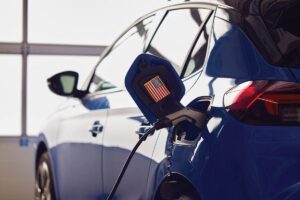In recent years, the electric industry has been abuzz about an alternative source of power parked right outside many homes — electric vehicles (EVs). Emerging technology offers the capability — for some EV owners now, and perhaps for many other owners in the years to come — to use their EV batteries for more than just powering their electric car, SUV or truck.
According to Clean Energy Reviews (CER), emerging EV battery technology falls into three categories. The first is vehicle-to-grid (V2G), which allows EVs to export energy into the grid when demand is high. If thousands of EVs with V2G technology help supply energy to the grid when demand is high, this technology “has the potential to transform how electricity is stored and generated on a massive scale,” according to CER.
The second type, vehicle-to-home (V2H), is when energy stored in an EV is used to power a home or business. However, this is not a common practice yet, since this type of setup requires a bidirectional charger and other specialized equipment to safely execute the transfer of power.
The third type, vehicle-to-load (V2L), allows an EV to directly power regular household appliances or charge other EVs. This type does not require a bidirectional charger since it is built into the vehicle. For example, the Ford F-150 Lightning can supply 9.6 kilowatts of power through its up to 11 120-volt and 240-volt outlets. Other vehicles with V2L technology include the Hyundai IONIQ 5 and the Kia EV6, according to CER.
Using EVs to power homes
Many all-electric vehicle batteries store approximately 67 kWh, which provides more than enough juice to power a home for three days in the event of a major power outage. This is significant given that vehicles are parked and unused for approximately 95% of their lifespan.
However, using an EV as a generator during power outages requires specialized equipment: an 80-amp bidirectional charger and a home integration system, which is a hardware unit that allows you to disconnect your house from the grid and power it with your vehicle.
Ford introduced the F-150 Lightning in 2021. During the ice storm that struck Texas that year and left millions of residents without power, Ford dealerships loaned out their all-electric F-150s as generators. This action encouraged other EV manufacturers to consider the potential of their EV models as generators, but it is not as simple as plugging an EV into a home’s power grid.
While other EVs, like the Nissan Leaf and Volkswagen EVs from 2022 onward, can perform bidirectional charging, currently only Ford offers the necessary components to make this work in a residential home. The system, known as Intelligent Backup Power, is currently available in conjunction with the F-150 Lightning and requires professional installation at an additional cost to the homeowner.
Is using your EV battery safe?
It is essential to ensure your vehicle’s battery is in top condition and that the installation of the bidirectional charger and home integration system is done by a professional electrician or licensed contractor, thereby minimizing the risk of fire to your home and vehicle.
Safety note
Bidirectional chargers and associated hardware/equipment should be installed by a licensed contractor who can assess your home to ensure it can handle the charger’s load and that all components are wired to code. Overloaded circuits can overheat, which can cause a fire. Only manufacturer-approved brands of EV chargers should be used.
Photo courtesy of The Ford Motor Company










